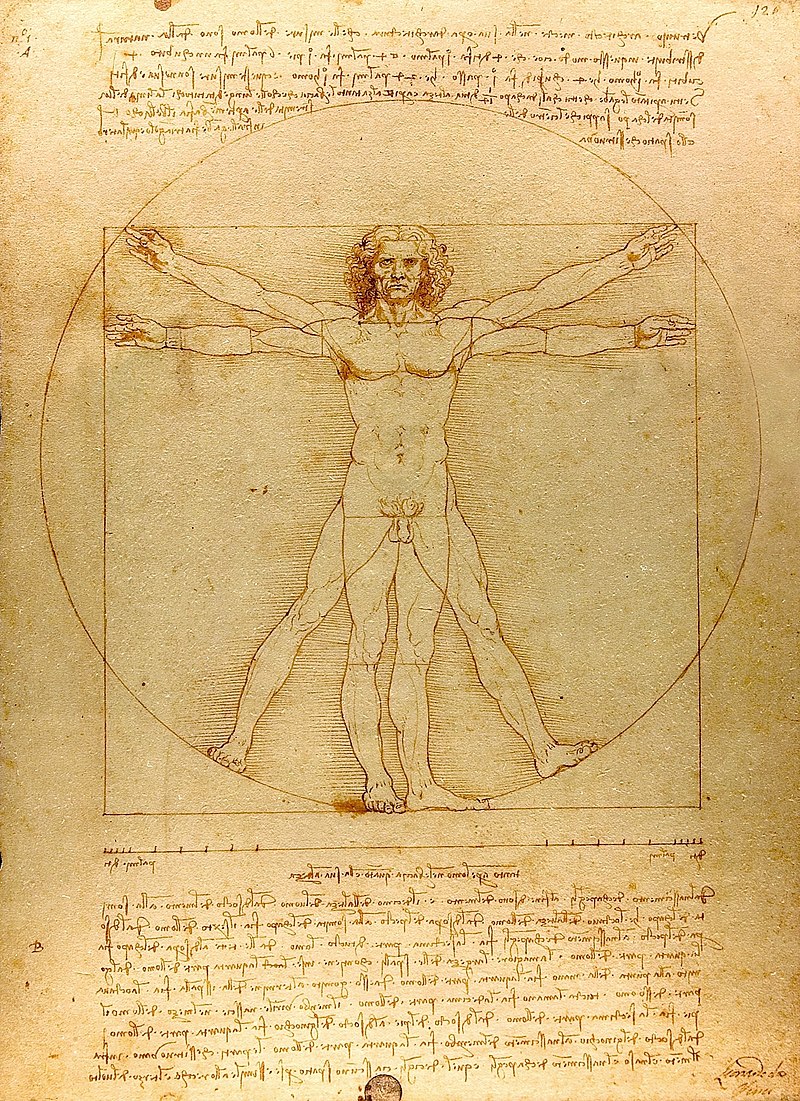
Wiki Leonardo da Vinci
Size of the Universe
In this model, the sun is a very tiny speck of dust indeed—a speck less than a three-thousandth of an inch in diameter … Think of the sun as something less than a speck of dust in a vast city, of the earth as less than a millionth part of such a speck of dust, and we have perhaps as vivid a picture as the mind can really grasp of the relation of our home in space to the rest of the universe. —
Sir James Jeans In The Universe Around Us (1953), 96.
Relative Size of Things
| structure | size of structure |
| coffee bean | 12 X 8mm |
| grain of rice | 8 X 2.5mm |
| sesame seed | 3 X 2mm |
| grain of salt | .5mm |
| ameba | 500 microns |
| paramecium | 210X60 microns |
| human ovum | 130 microns |
|
photoreceptor |
100 X 2.5 microns |
|
sperm |
60 X 5 microns |
|
skin cell |
30 microns |
|
red cell |
8 microns |
|
X chromosome |
7 microns |
|
baker’s yeast |
3 X 4 microns |
| E Coli bacterium | 3 X .6 microns |
| mitochondrion | 4 X .8 microns |
|
lysosyme |
.1 micron |
|
measles virus |
220 nanometers |
| influenza virus | 130 nm |
| hiv virus | 130 nm |
| coated vesicle | 90 nm |
|
hepatitis virus |
45nm |
| rhinovirus | 30nm |
|
ribosome |
30nm |
| ribosome | 30nm |
|
antibody |
12 nm |
|
tRNA |
7nm |
| phospholipid | .9 X 3.4nm |
|
methionine |
1100 X 700pm |
|
adenine |
1300 X 760pm |
|
glucose |
900pm |
| water molecule | 275pm |
| carbon atom | 340pm |
References
Carl Sagan http://www.youtube.com/watch?feature=fvwp&v=t4Tst9DZFPI
|
The evaluation of size can take many forms. Most the time in medical imaging we consider a linear measurement since it is the easiest for us to measure. Yet other dimensions including mass, weight, velocity, volume, frequency, velocity, and concentration, are in some way a reflection of size as well.
As a reference it is useful top review the size of some normal structures both at a microspcopic level and a anatomic level
capillaries which average 8 microns in diameter but may be as small as 4 microns –
red blood cells (7.8 micron x 2.6 micron biconcave disks) must fold in half to pass, single-file.
average animal cell is 10 -20 microns
human hair is about 80 microns
human eye can see up to 50 microns
sperm 60 X 5 nm
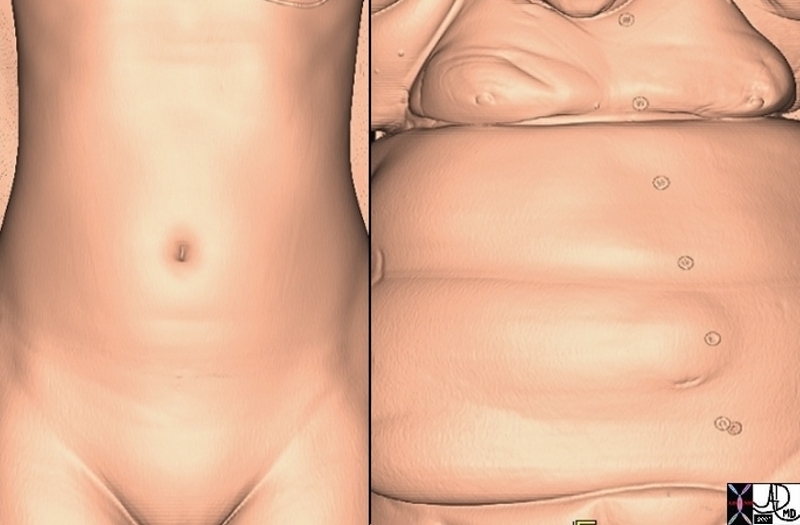
These images are derived from reconstructed CT images from a normal (left) and an obese patient (right). The manner in which the excessive tissue lays in folds in the obese patient, reflects that the excess tissue is due to the deposition of fat in the subcutaneous layers. Shape is a clue to the cause of the enlargement.
49609c02 abdomen health disease normal obese morbid obesity order disorder Davidoff MD
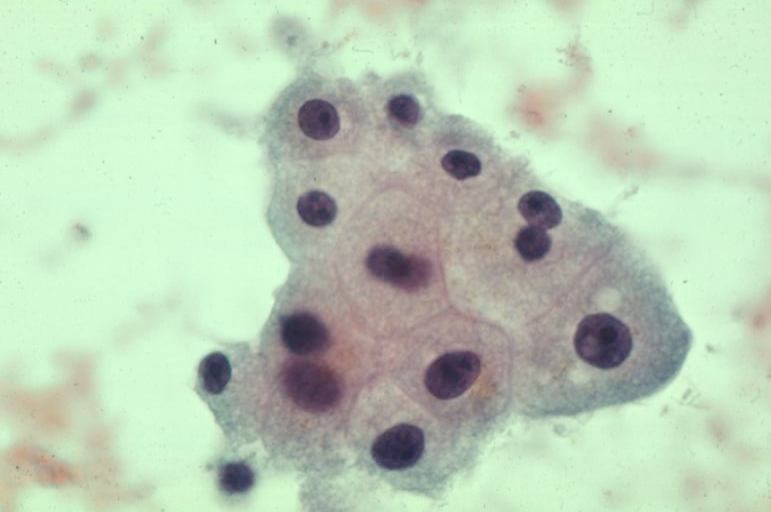

Nuclear-Cytoplasmic Ratio
The normal (left) and the abnormally large nucleus (right)
Two histological sections above show a normal nuclear cytoplasmic ratio of some liver cells on the left and cells with an increased nuclear cytoplasmic ratio on the right indicating malignant change. The experienced eye and mind of the pathologist develops a geshtalt of what the normal ratio. This is a difficult measurement to make objectively.
13440 13447Courtesy Barbara Banner MD
In this instance, making the assessment of an increase in the nuclear to cytoplasmic ratio is of the highest importance in the patient’s prognosis. If the nuclear cytoplasmic ratio is increased then a major criterion in the diagnosis of malignancy is recorded by the pathologist. The distinction between making a diagnosis of life threatening malignancy or not is as simple yet profound as that. It has its basis in the assessment of size.
Many diseases result in structures getting bigger. These encompass a variety of structural changes including neoplasia, hyperplasia, and hypertrophy. Diseases may also be caused by smallness of structure, with examples such as atrophy, hypoplasia, aplasia and atresia. Other disorders that may be associated with smallness include infarctions of the brain or spleen, congenital disorders such as hypoplastic right heart syndrome and esophageal atresia (esophagus is small and not formed) and immune disorders where tissue is destroyed such as sprue, or atrophic gastritis.
Evaluation of the magnitude of structure (and function in many ways) is a fundamental aspect of medicine. It is difficult to have a sense of how size fits into the clinical picture when it is learned in the context of basic science, but it always holds tremendous importance in the clinical realm.
The evaluation of size can take many forms. Most the time in medical imaging we consider a linear measurement since it is the easiest for us to measure. Yet other dimensions including mass, weight, velocity, volume, frequency, velocity, and concentration, are in some way a reflection of size as well
It may be useful to review the size of some common structures both at an anatomic level as well as a microscopic level in order to get a perspective.
The largest organ in the body is the skin, and the largest gland in the body is liver. The liver weighs about 1200 grams. Other large organs include the lungs which by volume are the largest, but by weight are not. The femur is the largest and longest bone in the body. The intermediate size organs include the brain heart, spleen and kidneys. The smaller organs include the pancreas, gallbladder uterus, and smaller than they are ovaries, thyroid and testes. Yet smaller are the adrenal glands, parotids, submandibular glands and the parathyroids.
| structure | length | widthant-post | trv | weight | volume | other | comment |
| adrenal | 3-5cms | 8gms | |||||
| aorta | 3cms proximal1.75cms distal | ||||||
| breasts | 30-500gms | ||||||
| bile duct | 5mm | CHD at level of right hepatic artery | |||||
| brain | 1400gms | 1000-15000mls | |||||
| cervix | 2.5cms | 5cms | 2.5cms | ||||
| colon | 150cms5ft | 5cms | |||||
| duodenum | 25cms | ||||||
| esophagus | 25-30cms | 2cms | |||||
| fallopian tube | |||||||
| femur | |||||||
| gallbladder | 8-10cms | 3-4cms | 50-70mls | ||||
| heart | 12cms | 6 | 8-9cms | 230-340gms | |||
| IVC | |||||||
| kidney | 11.25cms | 5-7.5cms | 125-170gms | ||||
| liver | 12-15cms | 10-12.5cms | 20-22.5cms | 1200-1800gms | largest gland in the body accounting for 2% of body weight and aslo the largest abdominal organ | ||
| lungs | 24cms | 630gms right570gms left900-1200gms | 4200-6300mls | 40% to 50% of the weight is bloodthe right lung is slightly heavier than the left lung | |||
| lymph node | <1cms | ||||||
| ovary | 2.5-5cms | 1.5-3cms | 1.5-3cms | 3-18mls | |||
| pancreas | 12-15cms | 1.5-3cms | 60-100gms | ||||
| pancreatic duct | 1-3mms | ||||||
| parathyroid | |||||||
| pituitary | 8-9mms | ||||||
| prostate | |||||||
| pulmonary vein | |||||||
| pulmonary artery | |||||||
| spinal cord | |||||||
| spleen | 12cms | 7cms | 4cms | 80-300gms | 250-350mls | ||
| small bowel | 700cms23feet | 2.5cms | |||||
| stomach | |||||||
| thyroid | 4-6cms | 1-2cms | 2-3cms | 10-20gms | |||
| testis | 5cms | 3cms | 2cms | 15-20ccs | |||
| trachea | 2cms | ||||||
| ureter | 25-30cms | ||||||
| urethra | 4cms F17-20cms M | 6mms | |||||
| urinary bladder | 12cms | 250 – 500mls | |||||
| uterus | 5-8cms | 1.5-3cms | 2.5-5cms | ||||
| vein | |||||||

Fom Freitas RA Junior Nanomedicine Volume 1 Basic Capabilities
Philip B. Hawk, Bernard L. Oser, William H. Summerson, Practical Physiological Chemistry, 12th Edition, The Blakiston Company, New York NY, 1951.
Peter L. Williams, Roger Warwick, Mary Dyson, Lawrence H. Bannister, eds., Gray’s Anatomy, Thirty-Seventh Edition, Churchill Livingstone, New York, 1989.
International Commission on Radiation Protection, Committee II, 1959, “Permissible Dose for Internal Radiation,” Health Phys. 3(1960):1.
Ivan Damjanov, James Linder, Anderson’s Pathology, Tenth Edition, Mosby, St. Louis MO, 1996.
capillaries which average 8 microns in diameter but may be as small as 4 microns –
red blood cells (7.8 micron x 2.6 micron biconcave disks) must fold in half to pass, single-file.
average animal cell is 10 -20 microns
human hair is about 80 microns
human eye can see up to 50 microns
sperm 60 X 5 nm
bacteria are as small as 1 micron
E Coli = 2micrometers long
ribosome 25nm diameter
cell membrane = 7.5-10nm thick
DNA molecule is about 2nanometers thick (nano = 1 billionth of a meter)
hydrogen atom = .1nanometer in diameter
0.1 nm (nanometer) diameter of a hydrogen atom
0.8 nm Amino Acid
2 nm Diameter of a DNA Alpha helix
4 nm Globular Protein
6 nm microfilaments
10 nm thickness cell membranes
11 nm Ribosome
25 nm Microtubule
50 nm Nuclear pore
100 nm Large Virus
150-250 nm small bacteria such as Mycoplasma
200 nm Centriole
200 nm (200 to 500 nm) Lysosomes
200 nm (200 to 500 nm) Peroxisomes
800 nm giant virus Mimivirus
1 µm (micrometer)
(1 – 10 µm) the general sizes for Prokaryotes
1 µm Diameter of human nerve cell process
2 µm E.coli – a bacterium
3 µm Mitochondrion
5 µm length of chloroplast
6 µm (3 – 10 micrometers) the Nucleus
9 µm Human red blood cell
10 µm
(10 – 30 µm) Most Eukaryotic animal cells
(10 – 100 µm) Most Eukaryotic plant cells
90 µm small Amoeba
100 µm Human Egg
up to 160 µm Megakaryocyte
up to 500 µm giant bacterium Thiomargarita
up to 800 µm large Amoeba
1 mm (1 millimeter, 1/10th cm)
1 mm Diameter of the squid giant nerve cell
up to 40mm Diameter of giant amoeba Gromia Sphaerica
120 mm Diameter of an ostrich egg (a dinosaur egg was much larger)
3 meters Length of a nerve cell of giraffe’s neck
Reference Wikibooks
interactive relative sizes (Utah)
Principles
Linear Measurements Length Diameter Radius
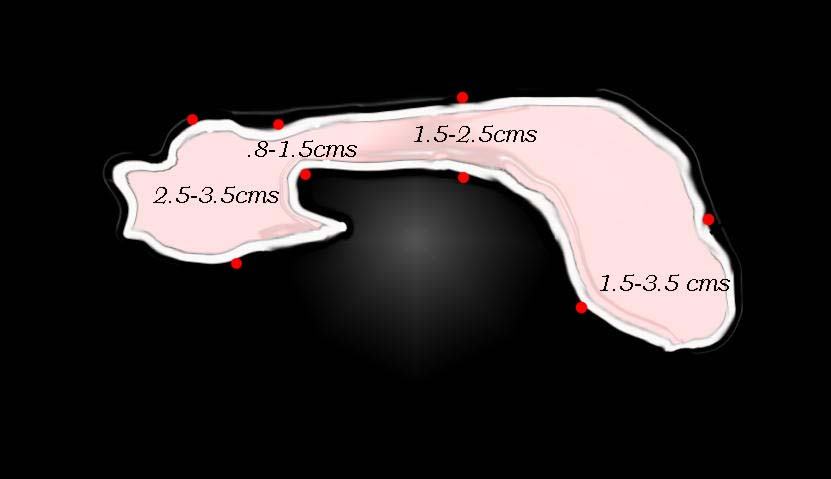
Size of the Pancreas
41394size002b01 Courtesy Ashley Davidoff MD code pancreas size normal anatomy imaging drawing
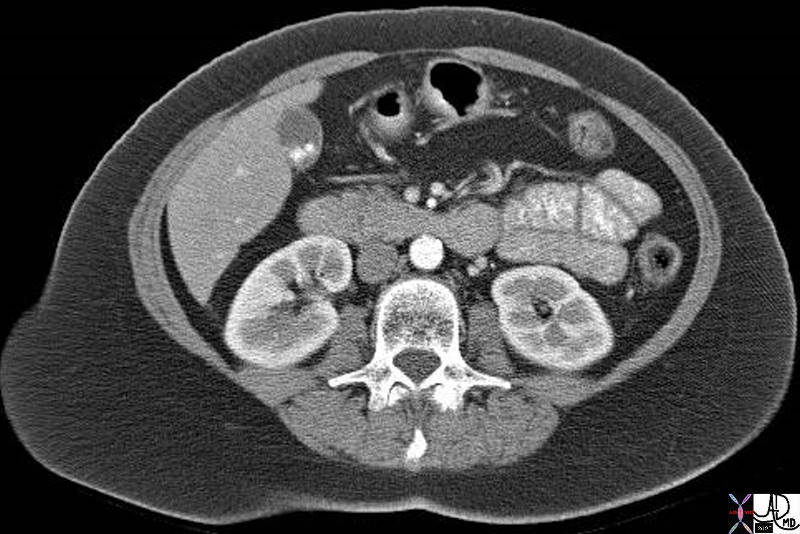

37004 abdomen aorta kidneys cortical phase subcutaneous fat adipose tissue normal anatomy gallsones cholelthiasis CT scan Davidoff MD18269 aorta abdomen AAA aortic aneurysm abdominal aorta retroperitoneum fx retroperitoneal hematoma fx active hemorrhage fx perinephric hematoma anterior pararenal space perirenal space posterior pararenal space hemorrhage dx rupture abdominal aortic aneurysm CTscan Davidoff MD fx ruptured AAA
Size and Time

Follicles in a Reproductive Female – Cyclical Phases -Size and Time |
| 71689 ovary follicles normal anatomy function physiology TCV Applied Biology Cycle time USscan Davidoff MD |
Size and Shape

Normal vs Atelectasis |
| 74238c01 88 year old male bilateral complex effusions pleura pleural space atelecactasis space occupation normal 3D volume rendering CTscan Courtey Ashley DAvidoff MD |
  Normal and Enlarged Abdomen Normal and Enlarged Abdomen |
| 45883.800 46133b03 abdomen skin size fx enlarged distended shape CTscan Cortesy Ashley Davidoff MD |
Thickening
|
Volume Frequency
Volume Loss on Left and Hyperinflation on the Right |
||||||
| This image is a combination of a plain film showing a hyperinflated and large right lung, with volume loss and cystic change in the left lung. Note the proximal trachea is pulled to the left by the contracted left lung, as welll as pushed by the hyperinflated right lung. Courtesy Ashley Davidoff MD. code lung pulmonary trachea mediastinum bronchioles pushed pulled deviated shifted hyperinflated dilated cotracted emphysema bronchiectasis imaging radiology CTscan CXR palin film chest X-ray |
 |
Volume Loss Due to Atelectasis and Effusion
74242b01 88 year old male emaciated thin 3D volume rendering CTscan Courtey Ashley DAvidoff MD
Volume
Volume Frequency
 Volume Frequency Volume Frequency |
| This diagram outlines the residual volume between the red lines, representing the air that is left in the airways and the alveoli after a full expiration. The air you may see on expiration CXR is the residual volume and as you can see it is about 1.8 liters in this patient. Courtesy Ashley Davidoff MD. 42529b06aa03 |
 |
Flow Velocity70294 acv waves hepatic veins doppler tricuspid valve regurgitation TR velocity Ultrasound Echocardiogram Davidoff MD
Weight
 |
Weight02300p.800 scale weight size anatomy structure applied biology Davidoff photography
  |
A Single Abnormal Gigantic Floret – Gigantism a Quirk of Nature
Variations in Size in Humans61229p flower allium size large elongated greater than the 90th percentile abnormally enlarged Davidoff photography
Former Olympian Olga Korbut (C) stands between Manute Bol (L) and William “The Refrigerator” Perry (R) during the weigh-in for Celebrity Boxing 2 in Los Angeles, California Tuesday, May 14, 2002. Korbut will face Darva Conger and Bol will face Perry during the boxing event which will air May 22 on Fox. REUTERS/John Hayes
54916.800
Olga 5feet 1 inch
Manut Bol 7foot 7 inches
William Perry 6’2” 370lbs
|
Body in Health and Disease49609c02 abdomen health disease normal obese morbid obesity order disorder Davidoff MD
CNS
Size – Number
 |
Multicentric Embolic Disease from Carotid Stenosis
72014c01 brain cerebral multicentric infarcts internal capsule parietal lobe cortex dx multicentric infarct left cerebral hemisphere associated with a left carotid stenosis with presumed showering of the embolic material embolism a = DWI b = T2 weighted
CVS
 |
Relative Size – Small Left Kidney Normal to LArge Right Kidney13417 aorta abdomen iliac artery fx atherosclerosis kidney fx small dx RAS renal artery stenosis grosspathology Courtesy Ashley Davidoff MD
 |
Aortic Aneurysm
42358.800 aorta fx enlarged MPA pulmonary artery aneurysm of the ascending aorta CTscan Davidoff MD
 |
Normal and AAA
11976c01 aorta abdomen abdominal aorta renal afrteries kidney fx normal AAA abdominal aortic aneurysm horseshoe kidney angogram angiography lumbar arteries Davidoff MD
 |
Normal and Thickened Aortic Valve over Time07953c02 heart cardiac aorta aortic valve fx normal fx thickened fx bicuspid aortic valve fx calcified fx calcification fusion of the intercoronary commisures grossanatomy grosspathology Davidoff MD b Courtesy Henri Cuenoid MD
Size Incompatible with Life

Mitral AtresiaThis pathological image of the mitral valve is a close up of image 01810, showing an atretic MV with unformed and poorly formed elements including the chordae and papillary muscles. No lumen could be identified. The heart is incompatible with life
Courtesy Ashley Davidoff MD. 01813 (see 01810) code heart cardiac congenital grosspathology MV mitral atresia
 |
Normal Abdominal AortaThis is an angiogram of a normal abdominal aorta. It consists of a suprarenal and an infrarenal component separated by the origin of the renal arteries. See image 24877d for color overlay. Courtesy Ashley Davidoff MD. 24877b
| Infrarenal Abdominal Aortic Aneurysm |
| The digitally subtracted angiogram shows a fusiform infrarenal abdominal aortic aneurysm. There is mild ectasia of the right common iliac artery. Courtesy Ashley Davidoff MD 24590 |

| Ascending Aortic Aneurysm |
| This series of images are from a CTscan showing an ascending aortic thoracic aneurysm. There is evidence of heavy calcification of the aortic valve (aortic sclerosis), an aneurysm confined to the ascending aorta (b,c,d), and tortuosity of the descending aorta (d). The cause for the aneurysm is probably a combination of systemic hypertension, aortic stenosis and atherosclerotic degeneration of the wall. Courtesy Ashley Davidoff MD 19426c |
 |
Multicentric and Diffuse Narrowing of the Abdominal AortaIn this patient, the MRI shows narrowing of the abdominal aorta segmentally and diffusely in this patient who has Takayasu’s arteritis and aortitis – an inflammatory condition affecting the aorta and large arteries. 16917b Courtesy Ashley Davidoff MD
 |
Normal and ongenitally Stenotic Pulmonary ValveThese two pathological specimens of the pulmonary valve show the normal delicate leaflets of the normal valve (a) in comparison to the thickened leaflets of the bicuspid pulmonary valve Courtesy Ashley Davidoff MD 00272c01.800
 |
Severe Congenital Pulmonary StenosisThe lateral projection of this right ventricular angiogram reveals a case of severe pulmonary stenosis. The catheter enters the RV from the RA via the SVC. The RV inflow tract (purple) is hypoplastic. The vessels emanating and theRV inflow are coronary arteries that are filling in retrograde fashion are due to the suprasystemic pressures in the RV indicating svere pulmonary stenosis with prssures in the RV that probably exceed 100mmhg. The infundibulum (right ventricular out flow tract (blue) is slightly narrow since it is hyperdynamic in an attempt to force the blood through the stenotic valve. The valve (green) is doming into the PA due the severe narrowing. The narrowing causes turbulence which causes the post stenotic dilatation.
15036c01 Courtesy Ashley Davidoff MD

| Size and Shape – Play it again Sam |
| This angiogram in RAO projection shows a hypercontractile left ventricle that has a ballet shoe appearance, with mitral regurgitation filling the left atrium. The drawing shows the significant LVH small cavity of the LV, the area of subaortic muscle bundle (green) and the mitral regurgitation caused by the systolic anterior motion of the mitral valve. Courtesy Ashley Davidoff 34805 |

| Venturi – |
| Flow in this tube is demonstrated by the arrows going from right to left through a narrowingin the tube (red) demonstrating a vacuum or suction effect caused by the sudden acceleration of the fluid as it goes through the narrowing or stenosis. This is seen in the U shaped monometer with the fluid level in blue being relatively higher at the site of the stenosis in relation to the pressure more upstream. The suction phenomenon is kown as the Venturi effect is seen in IHSS where the narrowing of the LVOT causes a vacuum effect on the anterior leaflet of the MV resulting in mitral regurgitation. The Venturi effect is also utilised in the functioning of carburettors in fuel driven engines. 34807b05 |
 |
Left Heart Failure46786c01 heart cardiac pulmonary arteries arteries fx enlarged fx corkscrew interstitial edema LAE left atrial enlargement dx cardiac failure cardiac congestion CTscan Davidoff MD
 |
Varicose Veins – Aging BodyLegs and feet seated at a bench in Quincy market in downtown Boston Massachusetts. – What story can you tell? Courtesy Ashley Davidoff MD. 02012p code foot accessory interesting vein varicose age time elderly shoe Davidoff photography

| Size related to Volume and Pressure |
| This injection into the base of the aorta showing filling of a dilated right coronary artery, collateral flow through the septal perforators, into a dilated LAD and then into the main pulmonary artery. (MPA) This is a case of anomalous origin of the left coronary from the MPA. Courtesy Ashley Davidoff MD. 07024 |
|
Normal Alveoli of the Lung and EmphysemaThis diagram illustrates the branching pattern of the tracheobronchial tree that extends from the bronchi to the terminal bronchioles transitioning into the alveoli via the alveolar sacs. Courtesy Ashley Davidoff MD 32645b04b04
This diagram shows alveoli and respiratory bronchioles that are too large due to loss of elasticity, so that air cannot be moved efficiently through them This is a diagram of emphysema causing hyperinflated lungs lung volumes 32645b01.800
Davidoff art

| Large lungs |
| A patient with hyperinflated lung volumes, COPD, and emphysema with surgical removal of a lung carcinoma from the LUL. Note how flattened the hemidiaphragms are and note the large retrosternal air space and the shapoe of the chest – like a barrel – called pectus carinatum – or pigeon chest. The lungs are literally so large that they are pushing the chest wall forward. |
Courtesy Ashley Davidoff MD 30672c

| CT of emphysema |
| This high resolution image of the lung shows “Swiss cheese” like black holes in the lung characterizing early cetrilobular emphysema in the right upper lobe. This degree of emphysema may be seen in a patient who has smoked and is in the their late 40’s or early fifties or in an elderly patient as an age related change in their 70’s or 80’s who has not smoked. Courtesy Ashley Davidoff MD. 01b 32170 |

| Segmental emphysema |
| This is a chest CT of a 29 year old man man who has segmental emphysema in the right lower lobe and midle lobe characterised by lucencies at 3 and 12 oclock where there has been air trapping in the alveoli. The left lung is normal This condition is called Swyer James syndrome Courtesy Ashley Davidoff MD. (30314 ) |

| Emphysema |
| This is an image of an emphysematous lung. Note the larger air spaces where the septae between the alveoli, alveolar sac, salveolar ducts and respiratory bronchioles have been broken down. 19932e |
 |
Stenting the Obstructions0916030018 This is a case of a central squamous carcinoma causing obstruction of the right mainstem bronchus and SVC requiring stents in both. This image tells the story of how tubular transport function is compromised by reduced size, and how size can be restored by modern technology. 0916030018 Courtesy Ashley Davidoff MD size tracheobronchial tree SVC vein stent anatomy applied biology applied anatomy CXR
 |
Allergic Bronchopulmonary Aspergillosis
47114c01 bronchi lungs fx dilated enlarged impacted with sft tissue finger in glove dx allergic bronchopulomonary aspergillosis ABPA aspergillus dx infection inflammation CTscan Davidoff MD
 |
Big Lung Small Lung Big Bronchi Small BronchiThis CT image shows a hyperinflated and large right lung, with volume loss and cystic change in the left lung. Note the trachea is pulled to the left by the contracted left lung, and is pushed by the hyperinflated right lung. Courtesy Ashley Davidoff MD. (30079 30084 30085 30085b) code lung pulmonary trachea mediastinum bronchioles pushed pulled deviated shifted hyperinflated dilated cotracted emphysema bronchiectasis imaging radiology CTscan
|
Stricture of the Esophagus
73406.800 esophagus narrowing stenosis stricture distal esophageal stricture peptic stricture endoscopy Courtesy Joshua Namias
 |
Big Stomach17191 stomach gastric + fx dilated + enlarged gastrinoma + imaging radiology CTscan
 |
Big Stone00136 gallbladder stone large shadowing cholelithiasis imaging radiology USscan
 |
Small Stones – Cholecystitis00405 gallbladder multiple small dependant stones shadowing cholelithiasis gallbladder fossa fluid thickening acute cholecystitis positive Murphy’s sign imaging radiology USscan
 |
Small Pancreas Big Pancreas41394csize04 Courtesy Ashley Davidoff MD code pancreas size abnormal small enlarged anatomy imaging radiology CTscan
  |
Normal Liver and Cirrhosis
Parts of the liver changing in size reflecting disease. The first image reflects a normal liver In the second image the left lobe is relatively large while the right lobe is small. These finding are characteristic of alcoholic cirrhosis. Note the shape of the surface of the liver has also changed from being smooth to being nodular and the presence of aciteds reflects a combination of increased portal pressure and low proteins.
18135.800 46136 Davidoff MD

Normal Liver above Cirrhotic Liver belowThis diagram reflects the large left lobe of the liver in cirrhosis and the small right lobe. The caudate lob is not depicted. 42649c01 Davidoff art
GUT
 |
Normal and Small – Kidneys46566c01 kidney kidneys size normal small anatomy physiology Davidoff MD
 |
Follicles in a Reproductive Female – Cyclical Phases -Size and Time
71689 ovary follicles normal anatomy function physiology TCV Applied Biology Cycle time USscan Davidoff MD
 |
Sinle Kidney Bicornuate Uterus
46527c01 uterus kidney renal bicornuate uterus single kidney congenital abnormality congenital growth disorder USscan MRI Davidoff MD
 |
Normal Empty and Overdistended Symptomatic Full Urinary Bladder
70363c09 urinary bladder normal enlarged abdominal pain induration abnormal urinary reterention CTscan sagittal reformat Davidoff MD
 |
Hydrosalpinx
43 old female with right adnexal discomfort and prior history of pelvic inflammatory disease Findings on a transvaginal ultrasound show a dilated fallopian tube consistent with hydrosalpinx
uterus fallopian tube distended hydrosalpinx ultrasound USscan 83331.8s Courtesy Ashley Davidoff MD copyright 2009
|
Big Lymph Nodes Small AortaThis cross sectional image of the mid abdmen shows an aorta with an expanded diameter, which in this case is associated with an extremely small lumen. Note the wall of atherosclerotic calcification is on the inside of the soft tissue surrounding it. The case represents non-Hodgkins abdominal lymphoma that masquerades as an abdominal aortic aneurysm. The positioning of the calcification is key to this recognition. Courtesy Ashley Davidoff MD 15657
Skin

| Gynecomastia |
| 46621 hx 77 year old male with SOB breast pleura fx gynecomastia pleural calcification dx asbestos related disease dx asbestosis CTscan Davidoff MD 46621 46623 46624 46622 |
 |
Gallbladder Polyp surrounded by fluid – 3mms47017c01 gallbladder fx nodule fx adeherent fx non dependant size character through transmission dx gallbladder polyp Davidoff MD
  |
Varicose Veins in SVC syndrome38078 38078b01 this middle aged female with breast carcinoma skin veins pericardiophrenic veins pericardium pericardial fx collaterals varicocity varicose abdomen ascites dx SVC obstruction imaging radiology CTscan Courtesy Ashley Davidoff MD also code SVC syndrome
 |
Obesity pre and post bypass48433c01.800 55 F s/p gastric bypass 4 years prior a, c pre bypass b,d post bypass adipose tissue subcutaneous fat size stomach nutrition metabolic fatty liver steatosis morbid obesity gallbladder fossa fatty sparing CTscan Courtesy Ashley Davidoff MD
 |
Large Abnormal Pushing and Squeezing
61 year olsd female post op repair of ascending aortic aneurysm with Bental procedure with dropping blood pressure and odecreasing oxygen saturation aorta left atrium
47752c01 LA heart cardiacmediastinum fx compression of left atrium from anterior post operative nediastinal hematoma and posterior aneurysm of the descending aorta fx lingula atelectatasis and left lower lobe atelectasis bilateral pleural effusions dx supravalvular mitral stenosis CTscan Davidoff MD
 |
Size and Death46592c01 uterus OB pregnancy fetal demise spontaneous abortion shape size position heart rate USscan Davidoff MD death
Size in Numbers
 |
Satellite Nodules affect Staging of Cancer28980 chest lung spiculated mass satellite nodules malignant carcinoma CTscan Davidoff MD 28979 28980 28981 28984 28985 28986c01
|
|
| Ascending Aortic Aneurysm |
| 42358.800 aorta fx enlarged MPA pulmonary artery aneurysm of the ascending aorta CTscan Davidoff MD |
Malignant Behaviour – Size and Doubling Time
|
|
|
| Growth of a lung lesion over 7 months
48380c01 chest lung fx mass fx growth in 7 months dx metastattic squamous cell carcinoma head and neck primary primary larynx metastasis time size CTscan Davidoff MD 48383c01 48380c01 48383c02 malignant malignancy |
https://www.facebook.com/BornDifferentShow/videos/2027035494014541/?t=0
https://www.facebook.com/BornDifferentShow/videos/2083418425042914/?t=0
Father and Daughter with Huge Tongues
https://www.facebook.com/escuadraycompass/videos/2083453751869769/?t=0























